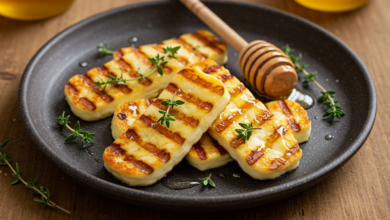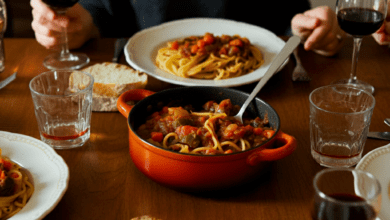How To Make Pastina: Your Italian Penicillin Recipe

When life throws colds, flu, or just a gloomy day your way, there’s nothing quite as soothing as a bowl of Pastina, often called “Italian Penicillin.” This tiny pasta holds a special place in Italian households, not just as a meal but as a comforting hug in a bowl. In this guide, you’ll learn everything about making the perfect Pastina Italian Penicillin Recipe while uncovering the cultural and emotional significance that makes this dish so beloved.
Table of Contents
What is Pastina? A Bite of Italian Tradition
Pastina, which translates to “little pasta,” is the smallest type of pasta. Its name may be modest, but its role in Italian cuisine is profound. These tiny grains or star-shaped pasta pieces are the go-to for hearty soups and light broths, especially when someone needs a pick-me-up.
Why is Pastina Called “Italian Penicillin”?
The term “Italian Penicillin” stems from its association with healing. Italians swear by its restorative powers, believing that the nourishing broth, combined with the simplicity of pastina, can work wonders during a cold or flu. Rich in protein from eggs and Parmesan and soothing to the digestive system, this dish truly feels like medicine disguised as comfort food.
Ingredients for the Perfect Pastina Recipe

Creating the ultimate bowl of Pastina Italian Penicillin starts with fresh, wholesome ingredients. Here’s what you’ll need:
| Chicken or Vegetable Broth | 4 cups | Homemade is best for full flavor |
| Pastina (tiny pasta) | 1/2 cup | Look for star-shaped varieties |
| Egg | 1 large | Whisked for creaminess |
| Parmesan Cheese | 2 tbsp | Freshly grated adds depth |
| Butter | 1 tbsp | Optional, for a rich finish |
| Salt and Pepper | To taste | Adjust to your preference |
Step-by-Step Guide to Making Pastina
With just a few simple steps, you can whip up a bowl of comforting goodness in under 20 minutes.
1. Prepare the Broth
Start by heating the chicken or vegetable broth in a medium saucepan over medium heat. If you’re using low-sodium broth, add a pinch of salt to enhance the flavor.
2. Cook the Pastina
Once the broth begins to simmer, stir in the pastina. Cook according to the package instructions (usually 5–7 minutes). Stir occasionally to prevent the pasta from sticking to the bottom of the pot.
3. Add the Whisked Egg
In a small bowl, whisk the egg until smooth. Slowly drizzle it into the hot broth while stirring constantly. This technique creates silky egg ribbons that enhance the texture and protein content of the dish.
4. Finish with Parmesan and Butter
Stir in the freshly grated Parmesan cheese until it melts into the broth. For added richness, toss in a tablespoon of butter and let it melt.
5. Season and Serve
Taste the soup and adjust the seasoning with salt and freshly cracked black pepper. Serve immediately, garnished with a sprinkle of Parmesan for that final touch.

Why You Should Love Pastina
A Nutritional Powerhouse
You might not expect such a simple dish to pack a punch, but Pastina is full of benefits:
- Protein-Rich: The egg and Parmesan provide essential amino acids.
- Gut-Friendly: Easy to digest, making it perfect for those with upset stomachs.
- Hydrating: The broth helps replenish fluids, especially during illness.
A Dish That Feeds the Soul
Beyond its nutritional benefits, Pastina connects you to cherished memories. Whether it’s a childhood meal prepared by a loved one or a remedy during a tough day, this dish is a reminder that simplicity can be powerful.
Variations to Explore
Pastina is endlessly versatile. Here are a few ideas to tailor it to your taste or dietary needs:
Add Vegetables
- Diced carrots, celery, or peas for a nutrient boost.
- Spinach or kale for added vitamins.
Protein Enhancements
- Shredded chicken or turkey for a heartier meal.
- For a vegetarian twist, add a poached egg on top.
Vegan Version
- Swap chicken broth for vegetable broth.
- Use nutritional yeast instead of Parmesan for a cheesy flavor.
Frequently Asked Questions (FAQ)

1. What makes pastina unique?
Its tiny size and ability to absorb flavors make pastina perfect for broths and soups. It’s also quick to cook, making it ideal for a fast, comforting meal.
2. Can I use gluten-free pastina?
Yes! Many brands now offer gluten-free options that work just as well in this recipe.
3. Is it necessary to use homemade broth?
Homemade broth elevates the flavor, but store-bought works in a pinch. Choose a high-quality brand for the best results.
4. How long does it take to make pastina?
From start to finish, this recipe takes about 15–20 minutes, making it perfect for busy days.
5. Can I store leftovers?
While pastina is best served fresh, you can refrigerate leftovers for up to three days. Reheat gently on the stovetop, adding a splash of broth if needed.
The Healing Power of Homemade Pastina
Crafting this Pastina Italian Penicillin Recipe isn’t just about cooking; it’s about creating something that heals, comforts, and nourishes. Each spoonful carries the warmth of tradition and the care of home-cooked meals.
So, the next time you or someone you love needs a little TLC, reach for this recipe. It’s more than food—it’s a timeless remedy for both the body and soul.
Did this recipe warm your heart and spark your interest? Share it with friends and family who could use a comforting meal. Don’t forget to bookmark this page so you can revisit it the next time you crave a bowl of love and warmth.
Let us know your thoughts or tweaks in the comments below—we’d love to hear how you make pastina your own!



